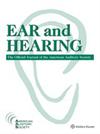针对聋人或重听者护理伙伴的污名化测量方法的开发和初步验证。
IF 2.6
2区 医学
Q1 AUDIOLOGY & SPEECH-LANGUAGE PATHOLOGY
引用次数: 0
摘要
目的 大量文献记载了护理伙伴在为各种健康状况的患者提供护理时所经历的身体和社会心理方面的巨大需求。然而,关于成年聋人或重听人 (d/DHH) 的护理伙伴的研究却少得多。针对这一空白,作为柳叶刀听力损失委员会 "措施、模型和减少耻辱感分组 "工作的一部分,作者制定了护理伙伴对 d/DHH 耻辱感的测量方法。本研究描述了五个污名化量表的初步验证,这五个量表专门用于评估美国成年 d/DHH 患者的护理伙伴中污名化的普遍程度和影响。这里所说的照料伙伴的定义比较宽泛,可以包括 d/DHH 患者的配偶、伴侣、成年子女、兄弟姐妹和朋友。这些量表描述了护理伙伴对 d/DHH 患者如何经历和感知成见的评估,以及护理伙伴自身因与 d/DHH 患者的关系而内化的、经历的和感知到的成见。后三组量表描述的是二次成见,即一个人因与被鄙视群体的成员交往而经历的成见。量表的开发过程包括文献综述、德尔菲小组(Delphi Group)、认知访谈以及预测试。结果支持五个成见量表的内部可靠性(序数α均大于 0.9),并且每个量表评估的是一个单一因素。经过进一步验证后,这些量表可用于评估污名化对 d/DHH 患者护理伙伴的影响,以及评估为解决污名化及其对护理伙伴和接受护理的 d/DHH 患者的影响而制定的干预措施是否成功。本文章由计算机程序翻译,如有差异,请以英文原文为准。
Development and Preliminary Validation of Stigma Measures for Care Partners of Persons Who Are d/Deaf or Hard of Hearing.
OBJECTIVES
A great deal of literature documents the significant demands, both physical and psychosocial, that care partners experience when providing care to persons with a range of health conditions. There is, however, far less research available on care partners of adult persons who are d/Deaf or hard of hearing (d/DHH). In response to this gap, the authors developed measures of d/DHH stigma among care partners as part of the work of the Lancet Commission on Hearing Loss' Measures, Models, and Stigma Reduction Subgroup. The measures examined in this article are part of a larger set of parallel measures to enable comparison of stigma measurement across groups.
DESIGN
The present study describes the preliminary validation of five stigma scales specifically tailored for use to assess the prevalence and effect of stigma on the care partners of adult people who are d/DHH in the United States. Care partners in this context are defined broadly and can include spouses, partners, adult children, siblings, and friends of persons who are d/DHH. The scales describe the care partner's own assessment of how the person who is d/DHH experiences and perceives stigma as well as the care partner's own internalized, experienced, and perceived stigma as a result of their association with a person who is d/DHH. This latter set of three scales describes secondary stigma, or the stigma a person experiences related to their association with a member of a stigmatized group. Measures were developed through a process that included a literature review, Delphi groups with people who became d/DHH after they developed spoken language, cognitive interviews, and a pretest. An online, self-administered preliminary validation survey was conducted with 151 care partners.
RESULTS
Results support the internal reliability of each of the five stigma scales (ordinal α's all greater than 0.9) and that each scale is assessing a single factor.
CONCLUSIONS
Additional testing is needed to confirm the validity of these measures. After further validation, they can be used to assess the prevalence and effect of stigma on care partners of persons who are d/DHH and to evaluate the success of interventions developed to address stigma and its effects both on the care partner and the person who is d/DHH and receiving the care.
求助全文
通过发布文献求助,成功后即可免费获取论文全文。
去求助
来源期刊

Ear and Hearing
医学-耳鼻喉科学
CiteScore
5.90
自引率
10.80%
发文量
207
审稿时长
6-12 weeks
期刊介绍:
From the basic science of hearing and balance disorders to auditory electrophysiology to amplification and the psychological factors of hearing loss, Ear and Hearing covers all aspects of auditory and vestibular disorders. This multidisciplinary journal consolidates the various factors that contribute to identification, remediation, and audiologic and vestibular rehabilitation. It is the one journal that serves the diverse interest of all members of this professional community -- otologists, audiologists, educators, and to those involved in the design, manufacture, and distribution of amplification systems. The original articles published in the journal focus on assessment, diagnosis, and management of auditory and vestibular disorders.
 求助内容:
求助内容: 应助结果提醒方式:
应助结果提醒方式:


